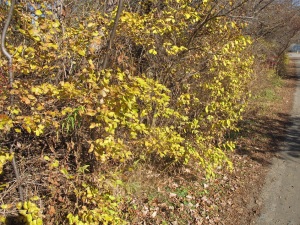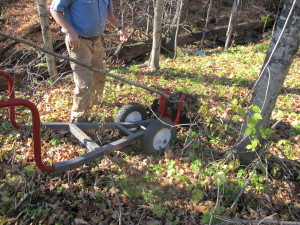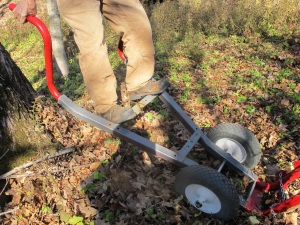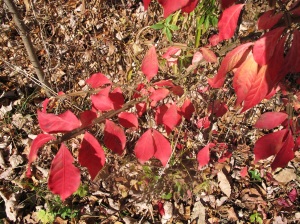Getting Rid of Invasives
Posted on Tuesday, January 21, 2020 · Leave a Comment
My mother used to say, “The road to hades is paved with good intentions.” That is particularly true for gardeners and plant collectors. Most of those nasty invasive plants we struggle to eliminate from our landscape were brought here from abroad by people who didn’t know better. They thought the plants would be a useful addition to their landscape. Plants such as barberry, Japanese knotweed and burning bush looked great to them. What they didn’t bring, of course, were the insects that eat them and keep their numbers under control in their native environments.
January is down time in the garden, generally. We can’t plant anything, and often the snow is deep. But if the January thaw has melted away the snow and ice where you are, this is a time when you could work on getting rid of some invasive trees and shrubs.
Actually, what I have I mind is helping to reduce the vigor and number of mature plants by cutting them down. That won’t kill them, but will keep them from producing seeds next year or even longer. Most invasives have roots that will send up new sprouts, come spring. And winter is not a time when you can dig up or pull out roots. But cutting them down and burning them is a chore you can do now.
The first task you have in this effort is to learn to identify the plants. For me, the most common invasive plants in the woods around my home are bush honeysuckle and barberry.
Invasive bush honeysuckle can get to be 10 to 15 feet tall and wide. It has fragrant white blossoms in June and oval-shaped leaves that are opposite each other on small twigs. In winter the bark is distinctive – slightly shaggy with distinctive ridges. If you cut a stem, there is a hollow spot in the center of the stem, though it might only be the diameter of a pencil lead. The shrub produces red or orange berries.
Japanese barberry is a tough plant that I have seen in deep woods, far from homes or roads. In full sun it produces massive quantities of red berries that birds eat and then drop the seeds all over. The bush has small green or purple leaves and is dense with thorns. I visited a barberry hedge recently, and it was still loaded with berries. The best solution? Cut it down now, and dig out the roots in the spring.
Burning bush ( Euonymus a) is on invasive species lists throughout New England, even though I rarely see seedlings in the woods, and have none on my property. It is best identified in the fall, when its scarlet leaves are noticeable. It is more of a problem in Rhode Island, Connecticut and Massachusetts. I once saw a bumper sticker that said, “30 Below Keeps Out the Riff-Raff. I assume it was talking about plants like burning bush which survives here, but doesn’t spread as fast as it does in warmer climes.
Buckthorns are small trees or large shrubs that are very difficult to eliminate. If you cut one down, the root system will send up many, many new shoots, come spring.
There are two different species of buckthorn common in New England: common buckthorn (Rhamnus cathartica) and glossy buckthorn (Rhamnus frangula), a smaller version with pretty shiny leaves. Both produce berries that turn a deep purple and are the size of blueberries, put with a pit in the middle like a cherry.
You can kill these two by double girdling the trunks with a hand saw, cutting through the bark and green cambium layer while avoiding the dense heartwood. By double girdling, I mean cutting two lines all the way around the stem a foot apart or so. If you do it now, the plants will leaf out and grow normally this year, and perhaps even next year, but then they will die – without sending up new shoots. I have done this.
By cutting through the cambium layer, no nutrients will be sent to the roots, and the roots eventually starve. Common buckthorn is often multi-stemmed with stems close together, so getting a saw in around each stem can be difficult.
Why bother with all this? First, although birds may eat the berries of invasive plants and distribute their seeds, they did not evolve with the plants and often do not benefit much from what they eat. The invasives also out-compete many of our own native plants. They leaf out earlier in the spring and drop leaves later in the fall than our natives. They often shade out or disrupt the growth of wild flowers, too.
Invasive trees and shrubs may be less attractive to the caterpillars that feed on our native trees and shrubs, and which are such an important food source for baby birds. Butterflies and moths lay their eggs on the leaves of native woody plants so that their caterpillar babies will eat well. Those caterpillars make up the vast majority of food for nestlings, even those species that develop into seed eaters. So avoid growing invasives.
Take advantage of the January thaw – or a thaw anytime this winter – and remove some invasive plants. Get a burn permit, some marshmallows and do your woods some good. And have fun!
Henry is the author of 4 gardening books. You can email him at henry.homeyer@comcast.net.
Invasive Plants
Posted on Wednesday, November 11, 2015 · Leave a Comment
Going for a walk the other day along a public trail I was struck by the number of invasive shrubs I saw. Most trees and shrubs have shed their leaves, but burning bush (Euonymus alatus), Japanese barberry (Berberis thunbergii) and honeysuckle (Lonicera spp.) still have leaves on their branches. Holding leaves and producing food by photosynthesis gives them extra energy to take over the world (or their world, anyway). This is a good time to pull a few of these out because many are very visible right now.

invasive honeysuckle
Why bother, you might ask? Because these invasive plants which come from the China or Japan have no natural enemies here. Left alone, they can take over the landscape, outcompeting our native wildflowers and understory shrubs, although that may take decades. In some places they have created monocultures by elbowing out other plants. Most birds, mammals and insects have evolved while depending on native species for their food and shelter. Do these shrubs provide food? Yes, but it is often not of the same quality as that of our native species.
Cutting down invasive shrubs will not necessarily kill them. Some invasive trees and shrubs react by sending up multiple new shoots from their roots. Instead of one buckthorn, for example, you suddenly have several in a circle around the tree you cut down. That increases the problem instead of solving it.
I have found that buckthorns can be killed without producing the root suckers if I double girdle the tree. By this I mean I cut a ring around the tree with a pruning saw, and then cut another ring a foot higher or lower than the first cut. I cut through the bark and the green cambium layer, but do not cut into the heartwood. If I do this now, the tree will leaf out next spring and the following spring, but slowly die by the third year. Patience is the key. The technique allows you to slowly starve the roots – they can’t get any nutrition from the leaves. Many buckthorns have multiple stems, and you must girdle every one to kill the roots.

Wheeled shrub puller
For small to medium sized invasive trees and shrubs, pulling them up is another option. I recently met with Gerry Hawkes, an inventor and forester in Woodstock, Vermont to try out a tool he developed to pull invasives (and do other tasks such as hauling firewood and moving large stones). It is a sturdy, 2-wheeled device that uses leverage to pull up a tree, roots and all. We pulled an inch-and-a-half buckthorn tree and a full size multi-stemmed honeysuckle with a trunk that was over three inches in diameter at the base.
The tool we used is called a Wheeled Post and Shrub Puller (http://wheeledhandtoolsystems.com). It is made of sturdy 2-inch square steel “pipe” and stands over 6 feet tall leverage when in the vertical pulling position.

Standing on shrub puller for maximum pulling power
We looped a light chain around the base of the tree and then attached it to one of four notches on the puller to allow us to begin with the best mechanical advantage, which is 12:1. I pulled down on the handle using my weight and it lifted the buckthorn partially out of the ground. Then, to get an even higher lift, we reset the chain to a different notch on the front of the tool and I got the root system right out of the ground! Since this tool is on 16 inch wheels, I was able to roll the tree away with little effort.
I have also used a hand tool called a Weed Wrench that pulls small trees and shrubs. Unfortunately, the company that makes these tools has gone out of business. It was made in four sizes with a gripping mouth-part that clamps down on a trunk, and a handle that uses leverage to pry out shrubs. Two other companies are now marketing similar tools, The Uprooter (www.theuprooter.com) and the Pullerbear (www.pullerbear.com). From what I have read, neither would compete with the tool I tried last week for pulling larger shrubs and small trees.

Burning Bush that self-planted
I think that using mechanical advantage to pull invasives makes much more sense than using chemical herbicides. But I don’t have personal experience following up over several years with invasives pulled: will the scraps of roots left in the ground survive and re-sprout? It’s possible that they will. Still, I think that Conservation Commissions and Garden Clubs would be well served by investing in pulling devices to share with interested townspeople and using along public pathways.
There are no plant police. No one can tell you that your invasive shrubs must be pulled up. Nurseries may not sell them, propagate them or transport them. But I am working hard at removing mine. And even if you live in a city, it makes sense to remove invasive plants on your property. Their seeds may wash down storm drains, and end up in a wetland or river – and spread their genetic material.
Getting rid of invasive plants takes time. I recently chatted with a woman who removed all the burning bush on her property 12 years ago. She is still pulling seedlings that germinate from seeds deposited over a decade ago. But, on the positive side, pulling “thugs” gives you more room to plant other nice landscape plants. So go look for invasive plants now, and try to get rid of a few.
Henry Homeyer is a gardening consultant and coach. He speaks to garden clubs and civic organizations about many aspects of gardening. Contact him at henry.homeyer@comcast.net or visit his website, www.Gardening-Guy.com.






